We’ve just returned from our last trip of the 2024 season, and though it’s always a bit bittersweet to wrap up the summer, we couldn’t have asked for a better final adventure. This trip was packed with exciting encounters and amazing team work, making it truly one for the books!
We were delighted to welcome Cindy Elliser from Pacific Mammal Research (Pac-Mam) back on board. Her insights are always valuable, and having her with us made this trip even more special!
Bottlenose, Spotteds, and Coral
Right off the bat, we were met with a challenge! We kept a watchful eye on Hurricane Ernesto as it threatened to come our way. Thankfully, it veered off our course, only bringing us some light wind, rain and waves before letting in the glassy seas and blue sky—nothing we couldn’t handle!
This trip served as an exploratory mission, focusing exclusively on Little Bahama Bank (LBB) as we worked to determine where these dolphins frequent. We traveled all the way up to Mantanilla in search of our dolphin friends, covering a vast area in our quest to better understand their travel locations and feeding habits. Along the way, we stopped for a beautiful snorkel on the massive and thriving reef at Mantanilla, which offered a glimpse into the vibrant underwater life that continues to flourish in this remote location.
We also took the opportunity to snorkel at Wood Cay Reef, a spot we hadn’t visited in a while. Unfortunately, this reef changed dramatically since our last visit, with most of the coral now lifeless and the fish population significantly reduced. This is a sad trend we’ve noticed at a few of our favorite spots, a stark reminder of the ongoing environmental challenges facing our oceans.
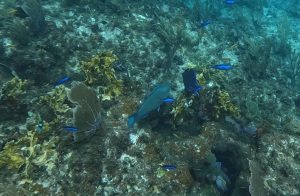 Stoplight parrot fish and tang at Mantanilla reef (Photo by Cindy Elliser)
Stoplight parrot fish and tang at Mantanilla reef (Photo by Cindy Elliser)
Dead coral with blue headed wrasse at Wood Cay (Photo by Cindy Elliser) 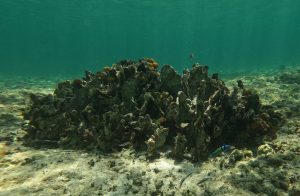
Our first encounter was with a group of over 15 bottlenose and a surprise bull shark sighting! It was amazing! These guys looked like potential hybrids between common bottlenose and offshore bottlenose—larger and darker than usual, with shorter rostrums. They were curious about us for just a few minutes, treating us to a symphony of brays, clicks, and lots of buzzing, before carrying on with crater feeding.
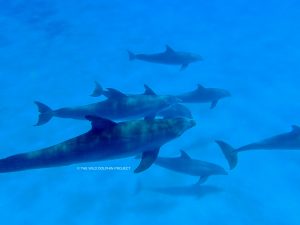 Group of bottlenose dolphin swimming by (Photo by Cindy Elliser)
Group of bottlenose dolphin swimming by (Photo by Cindy Elliser)
New Individuals at Little Bahama Bank
After a few days, we were ecstatic to finally encounter the LBB spotted dolphins for the first time since naming almost all of the 28 new individuals. We’re beginning to suspect that some of these may be new dolphins that have recently moved into the area as
opposed to old friends with new spots! For example, U24 stood out with his dark black birthmarks that surely would have been noticed before, yet he doesn’t match any of our existing records. The dolphins never cease to surprise us! Where do they come from?
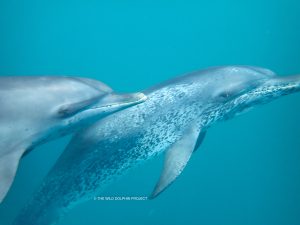 Zest with an unknown mottled male. (Photo by Cindy Elliser)
Zest with an unknown mottled male. (Photo by Cindy Elliser)
Some Familiar Faces
We had two encounters with some familiar older ladies, including Flying A, and Naia. Naia’s daughters Nera and Nala were there too, as well as, Zest! It was particularly exciting to reunite with Twix and her calf Toothless after naming them earlier this season. We also got to see Hades and confirm her sex as female, adding more detail to our ever-expanding catalog!
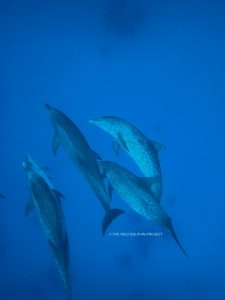 Group of spotted dolphins including Flying A, Twix, Toothless and U24 (far right)
Group of spotted dolphins including Flying A, Twix, Toothless and U24 (far right)
As far as endings go, we couldn’t have asked for a better one! We enjoyed beautiful weather, thrilling dolphin encounters, amazing sights, and even better company. As Winnie the Pooh says “How lucky I am to have something that makes saying goodbye so hard” (don’t worry, this is just see-you-later).
Our Season 2024 In Reflection
Our 40th season studying wild Atlantic spotted dolphins has been nothing short of extraordinary, blending familiarity with thrilling discoveries as we deepen our understanding of these beloved dolphins. We kicked off the season with stunningly calm weather, which allowed us to spend ample time on LBB. This was particularly exciting as we reconnected with some of our long- known dolphins, including the southern group that has remained on LBB, and discovered that they are not only thriving but expanding their population with a wave of new calves and juveniles. The detective work began early as we encountered many new individuals including some youngsters with few identifying marks, challenging us to track their development and integrate them into our extensive catalog of individuals.
As the season progressed, we enjoyed close encounters with these recognizable faces and newcomers. On our second trip, we were thrilled to spot Amanda with her new calf and rediscover Shades, a juvenile male last seen six years ago, now grown up and sporting more spots! The playful juveniles continued to entertain us with their antics, including one daring young female who taunted a shark, giving us a mix of amusement and concern for her safety. We also observed a few pregnant females and can’t wait to meet those calves next season!
Our travels took us from West End to Bimini, where we encountered a mix of behaviors, from large male coalitions displaying aggressive interactions to moments of courtship and parenting. Notably, we had an incredible encounter with a group of 35 dolphins, mostly males, whose interactions provided us with valuable insights into their social dynamics. The remarkable
experiences only continued with encounters with well-known individuals like Nautica. Her playful nature kept us entertained as she engaged in games of sargassum with both her fellow dolphins and our team!
Just as we inevitably face challenges during the season, the dolphins seem to as well! We observed a large group with many individuals bearing recent wounds. Most notably Sidewalk had a big gash on her left side and Burgundy’s calf, Briny, is now missing the majority of his dorsal and has a huge bite-mark scar on his right side. Luckily, these tough cookies seemed to
be unfazed by their tattered looks.
As we say goodbye to this field season, we’re filled with gratitude for the opportunity to call the Bahamas our summer home and to continue this important work. Each trip offered us unique experiences, introduced us to new friends—both cetacean and human—deepened our understanding of the environment, and provided us with a broader perspective on daily dolphin life. A huge “thank you” to everyone who has made this season so special! Here’s to the upcoming 2025 season and another 40 years of research, education, and conservation.
Until next time!
~ Allison Sanchez
